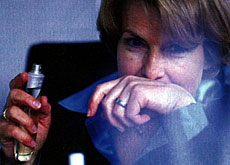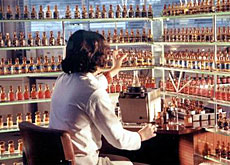Tracking down the scents of the natural world

Switzerland's Roman Kaiser has over the past three decades travelled around the globe chasing new scents.
It is a quest that has taken Kaiser – a chemist, botanist and perfumer at the Givaudan fragrances and flavours company – to such exotic places as Lower Amazonia, Papua New Guinea, India and many rainforest biotopes.
He has now documented his travels and exciting finds in a book “Meaningful Scents around the World”, which offers an insight into a realm in which most people would be lost.
Kaiser says that the sense of smell gives us a sense of other living beings, of our own species, or of animals and plants, and plays an important role in the forces ruling the living world.
“Scents open an additional dimension in your life. They tell you so much and together with visual perception they generate quite often aesthetic effects, so that something you see becomes even more beautiful because it has an attractive scent,” he told swissinfo.
Plant reproduction
Kaiser also explained that scents are vital for the reproduction of plants. “The only reason for a flowering plant to produce a scent is to attract a responding animal pollinator to ensure the preservation of the species.”
Since rainforests are home to about 80 per cent of all plant and animal species, it is hardly surprising that Kaiser and his colleagues spend a good deal of their time exploring them.
“The rainforests are by far the most life-intensive biotopes on earth and since natural scents are always ultimately connected to living beings, the chances are correspondingly high to be successful on such quests for new scent molecules and new scent concepts.”
The technique used involves taking samples by non-destructive methods only. This usually includes enclosing the flower in a glass vessel for up to two hours and capturing the natural scent in an adsorption trap.
This is later analysed in the laboratory using mainly gas chromatography and mass spectrometry, and the results can allow chemists to reconstitute natural scents.
Such methods have, over the past 25 years, allowed Kaiser and his colleagues to investigate more than 1,900 flower, plant, wood and herb scents out of a selection of about 9,000 species of plants evaluated during that time.
Expeditions
Kaiser explained there were two kinds of expeditions on the trail of new scent molecules – called by Givaudan ScentTreks – and both sound as though you need a good spirit of adventure.
“Papua New Guinea was like an expedition in the 19th century. We flew in to some of the rainforest villages. They have a small airstrip because there are no roads. And most of them are situated on a hill.
“You land going uphill and take off going downhill. [It’s] extremely exciting I can tell you, and from these villages you just walk and explore by hiking through the rainforests.”
That particular expedition involved local people and much preparation before it was possible to localise the interesting plants in the enormous richness there.
The other kind of search was for very defined species.
Dirigibles
“In French Guyana we had a different approach with dirigibles (small airships), which allows to approach the treetop region of the rainforest.
“The treetops are especially interesting because much has concentrated for ecological reasons in the canopy and therefore this is the most life-intensive biosphere of all. It’s the dream of botanists, biologists and of course scent researchers.”
What Kaiser calls “probably my last really big project” is entitled: The Scent of the Vanishing Flora, which has included an expedition to the Hawaiian Islands.
A book he is writing will include details of many highly endangered scented plant species before they probably disappear for good.
“With it, I would like to give something back to nature after I have studied it for more than 30 years,” he said.
Roman Kaiser’s book “Meaningful Scents around the World” is published by Helvetica Chimica Acta and Wiley-VCH.
It has three sections:
Introduction to the World of Natural Scents
Strolling in the World of Scents
Analytics
Until the middle of the 19th century, natural extracts of scented flowers or other plant parts, together with some animal secretions, were the only raw materials used in the creation of fragrances.
Chemists working in the fragrance industry have been investigating natural products extensively since the dawn of modern organic chemistry.
As a result of this continuing research work, perfumers now have at their disposal about 500 regularly used natural products for the preparation of their creations, but at least double this number of synthetic fragrance compounds that have originated in one way or another from natural products.
Born in Kirchberg, canton St Gallen, in 1945, Roman Kaiser studied chemistry at Winterthur Technical College and in 1968 joined the Givaudan research centre in Dübendorf near Zurich as a fragrance and flavour chemist.
Since 1975 he has worked mainly on the investigation and reconstitution of all types of natural scents.
In more than 50 cases, the results of his investigations have been published in specialist journals.
He is also the author of a book entitled “The Scent of Orchids” which summarises the olfactory and chemical investigations of over 160 species.

In compliance with the JTI standards
More: SWI swissinfo.ch certified by the Journalism Trust Initiative












You can find an overview of ongoing debates with our journalists here . Please join us!
If you want to start a conversation about a topic raised in this article or want to report factual errors, email us at english@swissinfo.ch.